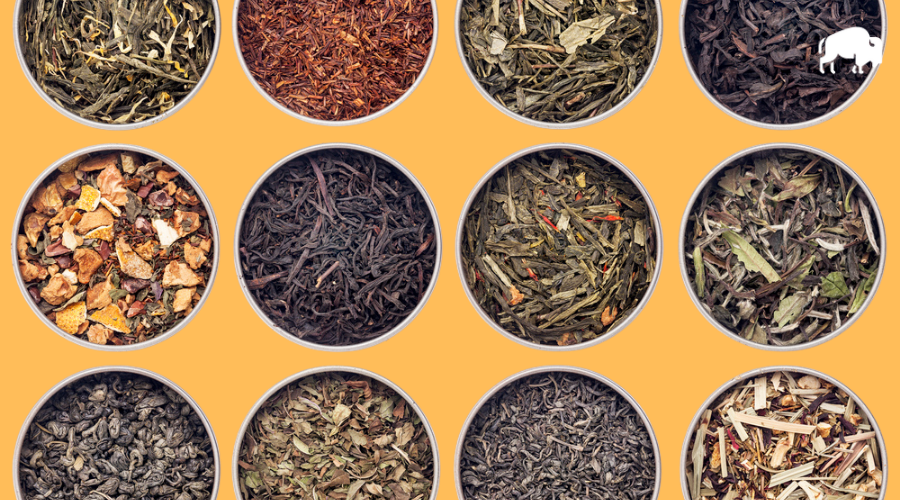Discover a world of flavors to add to your beer brewing repotaire. Discover the world of brewing with tea.
When adding tea during the brewing process, timing and type are everything. Similar to hops, when you add tea and what kind you add will produce very different outcomes. Fruity, smoky, earthy, herbal, floral, and more, flavors found in tea are diverse. Pairing with the right base beer is important in order to achieve complexity and unison.

What is Tea?
A warning should be issued here. If you go down the rabbit hole of tea, it will prove to be complex and interesting. And much like the brewing world it’s filled with differing opinions and myths.
Let’s get something straight. When we (in the USA) refer to tea, we are really talking about tea and herbs. This is not exactly accurate.
In this article, we’ll focus on tea. Tea is specific to the plant Camellia Sinensis. The tea shrub originated in southwest China and northern Burma.
Is Astringency Ok?
Astringency is considered by most to be an off flavor in beer. Almost all tea is inherently tannic.
In fact, tea is usually one of the items listed when we’re first learning about what astringency is.
If you’re using tea in the brewing process, some astringency is ok. There are levels that are unpleasant but lower levers come across more as bitterness.
How to Brew with Tea
What not to do
A few years back I was brewing a lychee-black-tea lager. It was a collaboration brew with a Chinese friend of mine. With an all-or-nothing attitude, we ended up adding tons of tea throughout the boil, after flame out, and as a dry tea addition.
As you can imagine, the result was a lot of lychee tea flavor…and a throat kicking amount of tannins. Don’t do this. Use restraint. Have patience and learn what each addition type imparts to your beer.
Types of Tea and Associated Flavors
There are six types of tea. It is generally regarded that each type comes from the same cultivar or type of tea plant. This is in fact erroneous but we don’t have time to discuss it here.
The six types are black, green, white, yellow, oolong, and pu-er (pronounced poo-are). The flavors of each one is different and the way they are traditionally brewed also varies. This is important because we can apply tea brewing methods to coax out desired flavors while leaving the behind undesired “off-flavors”.
Tea, like hops, will vary in flavor depending on the region and weather. Every year will result in a somewhat unique crop and flavor profile. Just like with grapes and wine, terroir is the name of the game.
Black Tea
This is the most well known tea in the west. Ironically, it’s not commonly consumed in China. The flavor is strong and tannic.
Other flavors range from nutty all the way to citrusy, depending on the region and processing methods. Black tea is intentionally oxidized and this gives it its distinct taste.
Use black tea at flameout and steep it for 3-5 minutes before chilling. Black tea can also be added like a dry hop addition. Simply bag it and toss it into a secondary or your primary for a day or two before packaging. This will result in a softer expression of flavor and less tannin extraction.
To get started with black tea, try using an English breakfast tea. This is a blend of black teas from around the world and will give you consistent results.
Green Tea
Green tea contains herbal, grassy, earthy, and floral flavors. Some green tea has sweet and citrus notes.
The way green tea is processed is unique. The leaves are harvested while still young and promptly steamed or fried to preserve them. The result is a less oxidized tea.
Because green tea is less oxidized, if it’s added to the boil or let to steep for more than a few minutes, a lot of tannins will be extracted. You’ll probably want to keep green tea out of any hot side additions.
White Tea
White tea is picked while the leaves are still developing. It’s processed carefully to preserve it’s antioxidants and other natural attributes.
The flavor of white tea is very subtle. It’s got a bit of the green tea herbal and floral notes but to a much less degree.
Because white tea has such a delicate flavor, it may not be the best option of brewing. That said, if the gravity and hops are kept in check, you may be able to coax a nice subtle complexity out of the leaves and into your brew.
Oolong
Oolong has the broadest range of flavors out of any type of tea. It is harvested fully mature and is highly influenced by terroir.
You’ll likely need to try a few specific Oolong teas first. Once you’ve got the flavors figured out you can dial in the base beer. Use it as a dry tea addition.
Pu-er
This is my personal favorite. It only comes from Yunnan, China. I’ve spent about 5 years in China and have a soft spot for a good cup of pu-er. At home and abroad it can be expensive.
There are two ways it is processed but the result is, debatably, the same. One of the methods involves fermentation. Both result in a tea that is less astringent but very full bodied. Think of it as the most flavorful and least bitter tea.
In terms of flavor, Pu-er can be nutty, floral, malty, honey, earthy, and dark fruity. It’s not likely that you’ll find all those flavors in one tea. Sampling will be necessary.
Because it lacks the typical astringency, up to a 30 minute steep after flameout can be done. Adding Pu-er tea on the hot and cold side should result in layers of flavor.
When, How, and How Much Tea to Add
Kettle
If adding tea to the kettle, 1 – 2 ounces is all you’ll need for a 5 gallon batch. Like most flavor additions, the amount needed will depend on the amount of hops and starting gravity. For example, 2 ounces of tea would be appropriate in an IPA with a starting gravity of 1.065.
Dry Tea Addition
When adding tea as a dry tea addition, use a measurement of 1 ounce of tea per gallon of beer. The extraction time will vary. Taste after 24 hours and determine if you should package or keep steeping.
Cold Steeping
For cold steeping teas and adding them into the keg or bottling bucket, use 1 – 2 ounces for a five gallon batch. Cold steep your tea with 2 cups of water in the fridge for 10 hours. Unless it’s green or white tea. For those, 7 hours will work.
Steeping
Steep your tea at the temperature and length appropriate for its type. These directions should have come with the tea. You’ll be making a concentrate so use 1 ounce for a 5 gallon batch and add the tea at packaging.
Brewing Unique Beers Course
If you want to take your tea beers to the next level, check out this Craft Beer & Brewing course:
Stuart Keating, co-founder and head brewer of Earthbound Beer in St. Louis, Missouri, shares what he's learned from years of experience in getting evocative (often beery) flavors out of a variety of unusual (often un-beery) ingredients.
It’s free for the first 30 days giving you access to over 60 homebrewing courses from the best brewers in the business.
Final Thoughts
There are a lot of options for brewing with tea. The best way to get to know a particular tea is to simply brew a cup, taste it, and take some notes. From there you can decide how the flavors will play off certain hops, malts, or other adjuncts.
Focus on one type and recipe and see what results you get. To get started, I recommend simply adding an ounce of black tea for a 3-5 minute steep in your next english style ale and see what the flavor impact is. So put down your coffee and get to work brewing with tea!
Frequently Asked Questions
How do I Avoid Astringency?
Cold steeping and adding tea or doing a “dry tea” addition in a beer will result in less tannin extraction. Less tannins equals less astringency. These methods will also result in a less pronounced flavor overall.
Will I get Caffeine from Tea in my Beer?
Yes and Maybe. There will definitely be caffeine if you’re brewing with tea on the hot side. Cold steeping tea should result in less caffeine extraction. But there isn’t a lot known about prolonged steeping. This is basically what is happening if you’re using tea as a “dry hop” addition. Assume it’s there.
What Flavor will I get from “X” Tea?
Because there is so much variety in tea. It’s hard to know what to expect. For a quick overview of some of the options out there take a look at this article from Craft Brewing Business.


